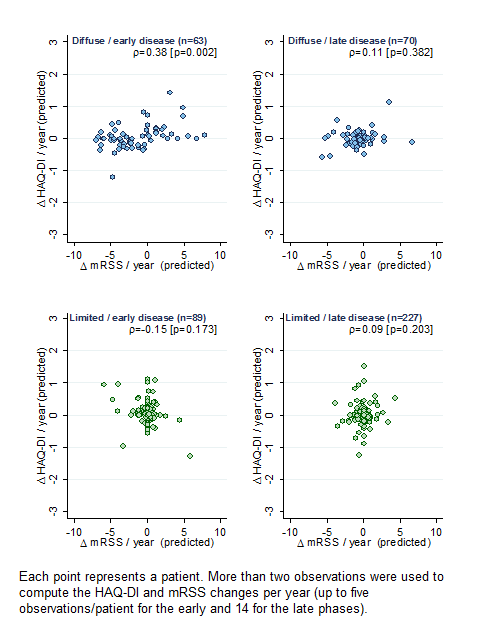Session Information
Date: Tuesday, November 7, 2017
Title: Systemic Sclerosis, Fibrosing Syndromes and Raynaud's – Clinical Aspects and Therapeutics Poster III
Session Type: ACR Poster Session C
Session Time: 9:00AM-11:00AM
Background/Purpose:
The burden of disability of systemic sclerosis (SSc) is increasingly recognised. What is less known are the factors driving this disability and how it changes over time. At a tertiary centre for SSc, clinical and disability data (including the Health Assessment Questionnaire Disability Index, HAQ-DI) have been collected systematically at annual review visits for over 20 years and stored electronically. This allowed us to test the hypothesis that disability is greater in patients with diffuse (dcSSc) compared to limited cutaneous disease (lcSSc) and that disability is associated with the degree of skin thickening in patients with dcSSc but not with lcSSc.
Methods:
This was a retrospective analysis of data collected from 1994 to 2016. For each patient, data were retained from the first simultaneous record of the HAQ-DI (0-3) and modified Rodnan skin score (mRSS, 0-51), measuring skin fibrosis. For each patient, HAQ-DI and mRSS trajectories were assessed separately for the early and late stages of the disease (with 5 years post first non-Raynaud’s manifestation as the cut-off). For the first visit, HAQ-DI and mRSS scores were compared according to disease stage and subtype. The yearly change in HAQ-DI and mRSS was computed for each patient using linear regressions for early and late disease phases and Spearman correlations were computed between changes in HAQ-DI and mRSS.
Results:
401 patients were included in the analysis, 292 (72.8%) with lcSSc and 109 (27.2%) with dcSSc. The mean disease duration at the first visit was 8.0 years (SD 7.9) and mean length of follow-up 5.9 years (SD 3.6). 73 patients were followed during early disease, 218 during late disease and 110 during both stages. At the first visit, patients with dcSSc had higher mean HAQ-DI scores (indicating more disability) than patients with lcSSc for early disease (1.4 vs. 0.9, p=0.003) but there was no difference in ‘late’ patients (1.6 vs. 1.4, p=0.221). The yearly change in HAQ-DI was very variable, with approximately half of the cohort improving while the other half deteriorated. In dcSSc, the changes in disability were associated with changes in mRSS in early (ρ=0.38, p=0.002) but not in late disease (ρ=0.11, p=0.382). In lcSSc, changes in mRSS did not associate with changes in disability in early or late disease (p=0.173 for early and p=0.203 for late) (Figure).
Conclusion:
These findings further benchmark the high disability in patients with SSc, and confirm that patients with the diffuse subtype tend to exhibit higher levels of musculoskeletal disability than those with limited disease. In early dcSSc, disability tracks over time with skin thickening, suggesting that in this subgroup skin fibrosis is a driver of disability, whereas in late dcSSc and in lcSSc other factors (e.g. severity of digital ischaemia) may contribute more.
Figure. Yearly changes in HAQ-DI and mRSS, according to disease subtype and stage.
To cite this abstract in AMA style:
Peytrignet S, Manning J, Wragg E, Moore T, Samaranayaka M, Herrick AL. Changes in Disability over Time, and Their Relationship with Degree of Skin Thickening, in Patients with Limited and Diffuse Cutaneous Systemic Sclerosis: A Retrospective Cohort Study [abstract]. Arthritis Rheumatol. 2017; 69 (suppl 10). https://acrabstracts.org/abstract/changes-in-disability-over-time-and-their-relationship-with-degree-of-skin-thickening-in-patients-with-limited-and-diffuse-cutaneous-systemic-sclerosis-a-retrospective-cohort-study/. Accessed .« Back to 2017 ACR/ARHP Annual Meeting
ACR Meeting Abstracts - https://acrabstracts.org/abstract/changes-in-disability-over-time-and-their-relationship-with-degree-of-skin-thickening-in-patients-with-limited-and-diffuse-cutaneous-systemic-sclerosis-a-retrospective-cohort-study/

